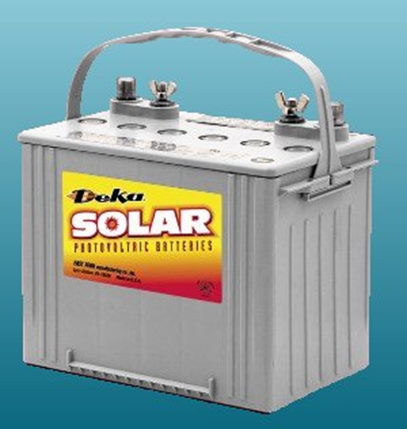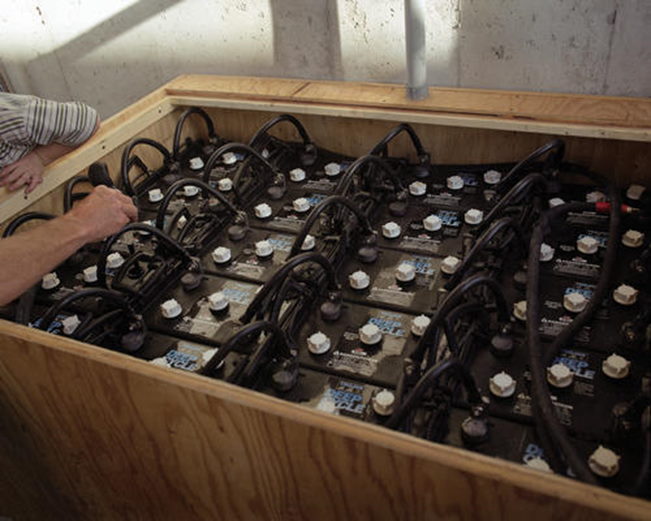Introduction
The most important thing to take away from this lesson is..
You don’t need to spend thousands of dollars on deep cycle batteries for your solar system.
Your battery bank is the heart and soul of a solar and/or wind energy system. Batteries are used to keep and store the electricity you generate for when you’ll need it.
Since the time at which your peak charging occurs rarely coincides with peak production times (our experience) then batteries are used for energy storage. Choosing the correct battery size is a important decision. Choose them too small and your system won’t perform the way it should, and will shorten the life of the batteries themselves. Choose too large and it will be difficult to maintain a full charge, again resulting in poor system performance.

Housing your batteries is also a decision. Your location should be warm enough (76 degrees F. or 25 degree C) because your battery will lose effectiveness below those temps. What this means to you, is if you choose to locate your batteries in an unheated space, you’ll need to insulate and provide some sort of heating mechanism.
You should also plan on greater battery capacity to compensate for the energy losses at lower temperatures. Make sure either your supplier knows about the planned location of your batteries or you take this into account.
Battery capacity (how many amp-hours it can hold) is reduced as temperature goes down, and increased as temperature goes up. This is why your car battery dies on a cold winter morning, even though it worked fine the previous afternoon. If your batteries spend part of the year shivering in the cold, the reduced capacity has to be taken into account when sizing the system batteries. The standard rating for batteries is at room temperature - 25 degrees C (about 77 F). At approximately -22 degrees F (-27 C), battery AH capacity drops to 50%. At freezing, capacity is reduced by 20%. Capacity is increased at higher temperatures - at 122 degrees F, battery capacity would be about 12% higher.
Your planned location for the batteries should also take into account maintenance and inspection as well as any safety factors. It should in an area which can be easily vented as well as
In addition, anything which can produce a spark should be kept separately from the battery housing. With that in mind, don’t locate batteries near a heat source or any area around open flames. Finally, if you can, read all material about safely using and operating your batteries.

Inside Locations
Batteries located inside your house should be properly vented to the outside. For small cottage systems with as an example, two 12-VDC (volt direct current) batteries, you need a vent that is at least 1 inch in diameter.
Keep batteries away from your living space by housing them in special battery cases and make sure they are properly ventilated to the outside.
For summer cottages you might want to think about keeping them fully charged to keep them from freezing during the off season.
Outside Locations
Batteries located outside you house should also be kept in a well ventilated box or shed designed for the purpose.
In extremely cold locations, you can house them in a buried container, as the ground will usually maintain a more constant temperature.
Batteries may give off hydrogen gas during charging and can be a source of electric shock, so the room and/or box needs to well ventilated.
In every situation, batteries should be well protected from the elements, well ventilated, away from sparks and open flames, and easy to maintain.
Maintenance usually consists of visually checking batteries for any leaks or damage, checking the electrolyte levels as well as verifying the specific gravity with a hydrometer. You’ll also need to add distilled water as necessary and possibly clean and tighten the connections.
OK, getting free batteries…
Believe it or not, there are a number of ways, and a number of places to procure your batteries. Like most things in this book, you need to think who already has them or uses them, and why would they throw them away.
Sometimes called "fork lift", "traction" or "stationary" batteries, are used where power is needed over a longer period of time, and are designed to be "deep cycled", or discharged down as low as 20% of full charge (80% DOD, or Depth of Discharge). These are often called traction batteries because of their widespread use in forklifts, golf carts, and floor sweepers.
And there you have it…
Any place that has industrial forklifts has deep cycled batteries. This list is endless. Every city or town has an industrial or manufacturing area. In truth, most businesses have a forklift around somewhere. What is even better is these work great with renewable energy systems.
Now what you want to target is a larger business that has many forklifts. Because they have regular maintenance schedules as well capital depreciation schedules to maintain. Most of these business will switch out their batteries every 5 years or so. The good news is, many of these batteries can last up to 20 years!
Try to talk to the maintenance supervisor, or operations manager, and ask about the batteries. Many times he’ll keep you in mind when the time comes to switch them out.
Another good place to find deep cycle batteries is at country clubs and golf courses. Why? Because golf carts use the kind of batteries we want.
Other locations for free deep cycle batteries:
Other locations for free batteries exist as well. These include RV repair and maintenance lots, as well as boat marinas. Many times you’ll find they have to pay to have the batteries taken away and disposed of properly.
This is where you come in.
Win/Win/Win.
This Week’s Assignment
1) Get started immediately looking for the best location for your battery bank. Explore whether it makes more sense to locate it inside of outside.
2) Start checking the yellow pages for country clubs and possible businesses that would have forklifts: Take a drive out to them and see if they would be suitable to approach. If so, no time is better than the present. You might feel awkward at first, but hey, in reality, you’re doing them a favor and saving money. Be sure to bring that point up.
PS…Don’t forget you can get personalized coaching at www.making-biodiesel-books.com/....html For some this is the ideal way to get hands on experience as well as personal attention needed to make this work for you.
